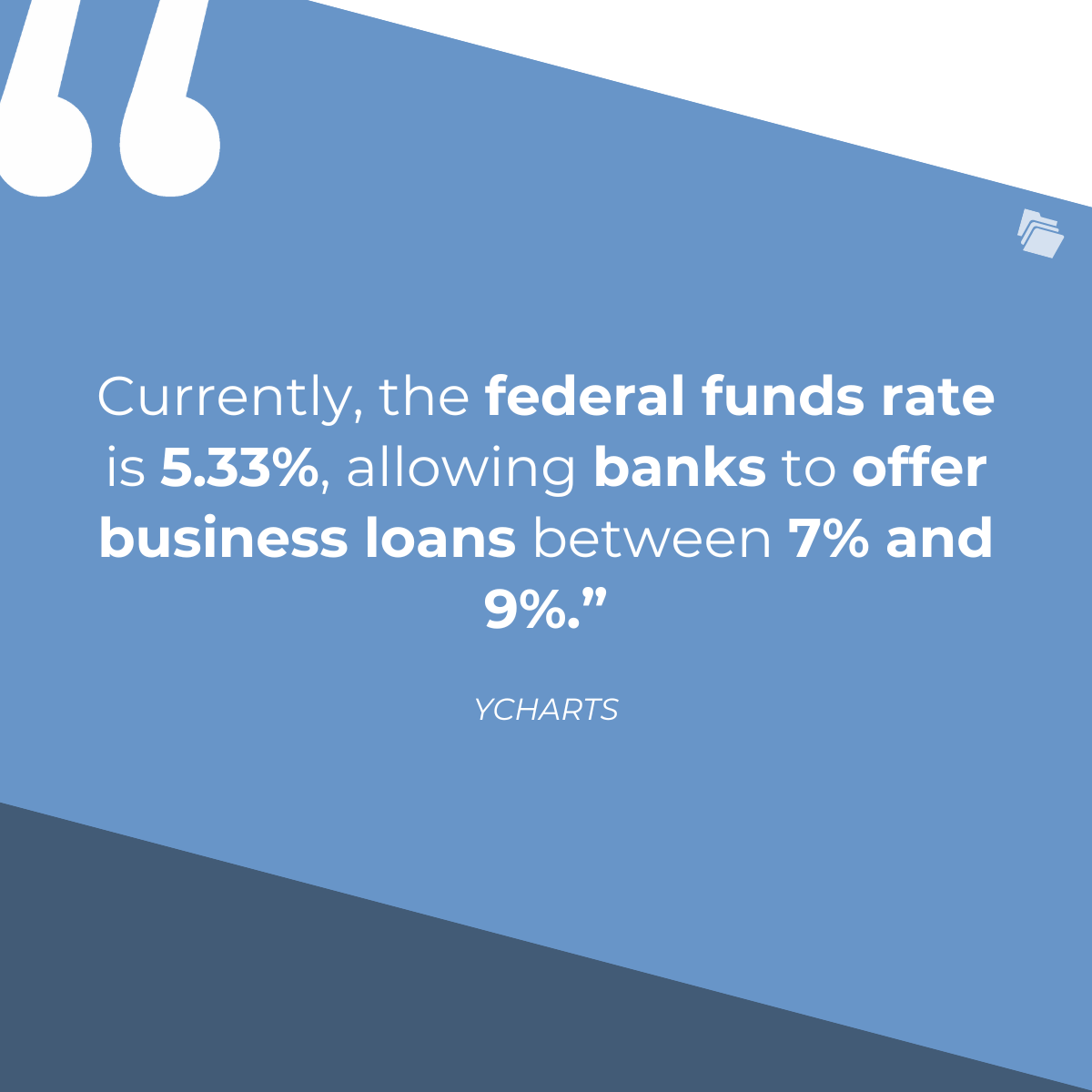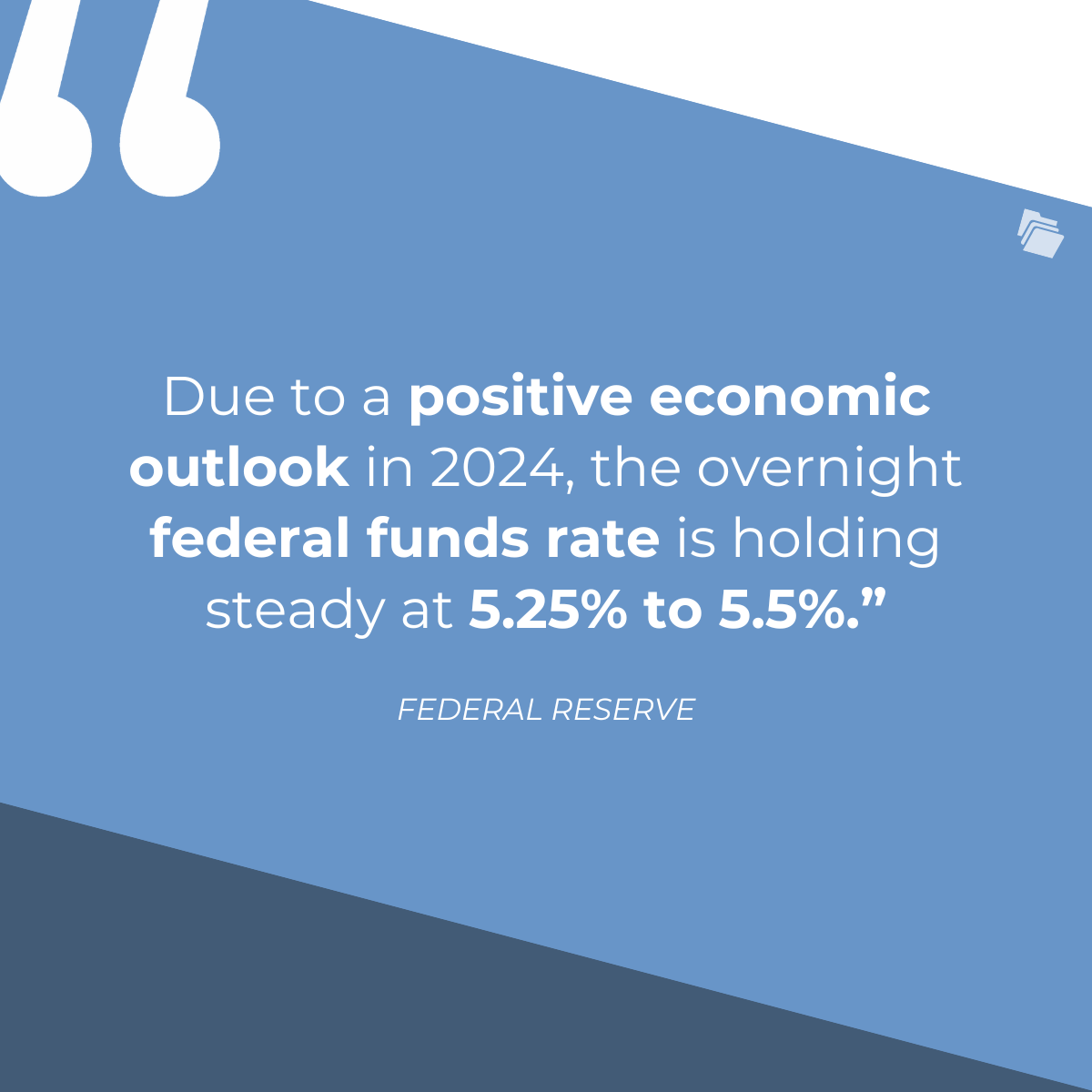When you approach your bank for a commercial loan, a loan officer evaluates your application to determine how much you can borrow and, more importantly, the interest rate. Given that the interest rate determines your cost of borrowing, it's only natural to wonder, "How do banks price commercial loans?"
Typically, banks use the federal funds rate and a risk-based approach to determine the interest rate for each loan product. Currently, the federal funds rate is 5.33%, allowing banks to offer business loans between 7% and 9%.
Dig in as we detail how banks determine the interest rate on your commercial loan.

The Benchmark Set by the U.S. Federal Reserve Bank
The United States Federal Reserve uses the federal funds rate to establish a benchmark bankers use to determine their lending rates. It refers to the interest rate banks use to trade with the Fed and lend money to each other. This rate is the benchmark for short-term interest rates for the financial markets.
The Fed has the sole authority to raise or lower the interest rates and uses the federal fund rates to effect these changes. Banks institute interest rate changes that closely mirror the changes in the Federal Reserve rate.
Changes in the federal funds rate have a ripple effect on the cost of borrowing. A high rate increases the cost of borrowing since banks charge higher rates. Conversely, a drop in the Fed base rate drives banks to lower their lending rates.
The Federal Reserve often uses monetary policy — actions to control inflation, manage the money supply, and stabilize the economy — to influence the cost of borrowing. The policies depend on the prevailing economic state. During periods of high inflationary pressure, the Fed raises interest rates, prompting banks to hike their rates. During recessions, the Fed may lower interest rates to allow banks to offer affordable rates.
Applying Complex Loan Pricing Models
Banks make most of their profits as net interest margin (NIM) by offering customers deposits as loans. The profit is the difference between what the banks earn from long-term loans and what they pay as interest on deposits. Banks can set their interest rates guided by the Federal Reserve and market-based factors.
Typically, banks turn a profit when they maximize the steepness of their yield curves — a graph representing the difference between the short- and long-term interest rates. Due to spiking competition, lenders increasingly leverage technology and affordable interest rates to attract borrowers. Staying competitive gives banks a much-needed lifeline while allowing them to lend profitably and delight their shareholders.
Usually, banks use three primary pricing models — cost-plus, price-leadership, credit score, and risk-based pricing to determine how much interest to charge on loans. They also consider the collateral and the loan duration when setting the interest rates.
- Cost-plus model: It uses four factors — funding costs, operating costs, risk premium, and profit margin — to calculate the interest rate.
- Price-leadership model: Large banks use their strong financial position to offer the best interest rates on the market.
- Credit score and risk-based pricing: This model uses the borrower's credit score to determine the risk of default. It allows banks to offer optimal rates to low-risk borrowers and premium rates to high-risk borrowers.
Lenders are increasingly using the price-leadership pricing model to set interest rates because it allows them to consider their competitor's interest rates when setting their own. With this approach, large banks use their considerable financial muscle to differentiate their offerings without compromising profits.
Scrutinizing Borrower's Creditworthiness
Banks use creditworthiness to determine the risk level of lending money to your business. Creditworthiness helps lenders understand your financial position and capacity to handle new debt obligations.
Lenders defer to your credit score — a 3-digit number based on financial history and conduct. A business credit score is a summation of your payment history, length of credit history, past and current debt, and types of credit used. It ranges from 0 to 100, with higher scores indicating stellar creditworthiness.
Banks reward creditworthiness with favorable loan terms. They offer their best customers a prime rate lower than the prevailing market rate because they pose a lower default risk. However, they may deny loan applications or offer the loan at a higher premium to borrowers with low creditworthiness. The higher rates help mitigate the risk of default and protect the bottom line.
Using Key Loan-Specific Factors
Alongside creditworthiness and the Fed rate, banks consider loan-specific factors such as the loan amount and terms when pricing commercial loans. Naturally, you'd expect the interest rates on larger loans to be higher than average, but that's not the case.
Typically, only businesses in excellent financial health — stellar credit history and high credit scores can qualify for substantial commercial loans. Such borrowers qualify for preferential interest rates because they're unlikely to default on loan payments. Conversely, businesses with lower credit scores may be eligible for smaller loans at higher interest rates.
Banks also consider the loan term when setting their interest rates. Short-term loans have a lifespan of under 18 months, while long-term loans are 3 to 10 years. A long-term commercial loan typically has a higher interest rate because it carries a higher risk exposure. You may secure better rates on a short-term loan because a shorter repayment period reduces the risk.
Accounting for Economic Conditions
Banks account for broader economic conditions when setting commercial loan interest rates because they affect the demand for business financing. They will lower rates during an economic downturn and raise them during strong economic growth periods. Due to a positive economic outlook in 2024, the overnight federal funds rate is holding steady at 5.25% to 5.5%.

Typically, bankers consider two closely related economic factors — inflation and unemployment — when pricing commercial loans.
Inflation
Inflation is an increase in the cost of goods and services over time. High inflation decreases the buying power and lowers discretionary income. When the Federal Reserve hikes the interest rates, the banks follow suit. High rates make borrowing expensive and slow down economic activities, which helps mitigate inflationary pressures.
During periods of low inflation — current inflation is below 3% — the Fed may lower the interest rates. Low-interest rates reduce the cost of borrowing and encourage spending to stimulate economic growth.
Unemployment
Unemployment levels are essential to lenders because they provide insights into the economy's health and labor market. Since high unemployment levels indicate a weak economy with poor spending power, the Federal Reserve may lower interest rates to let banks offer affordable loans.
Process Loan Applications up to 6X Faster with FileInvite
Banks use various factors to determine the interest rates when issuing a commercial loan. They range from loan-specific factors such as your credit score and financial history to prevailing economic conditions and the base lending rates set by the Federal Reserve. Surprisingly, spiraling competition in the banking sector also plays a considerable role when pricing commercial loans.
At FileInvite, we specialize in helping commercial lenders process loan applications up to 6X faster. Our innovative solution lets you transform your document collection process to help you seamlessly adapt to a dynamic business landscape. It also powers your ability to optimize and automate your workflow for speed and efficiency so you can scale your operations without incurring huge overheads. Our centralized client communication solution allows you to personalize the loan application process while enhancing the customer experience for a matchless edge on the market.
Looking to gain an edge on the market? Experience a more secure document collection with FileInvite — request a demo today!

Related Posts: